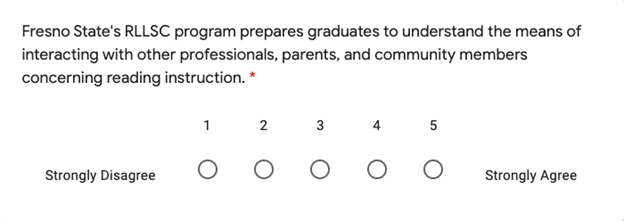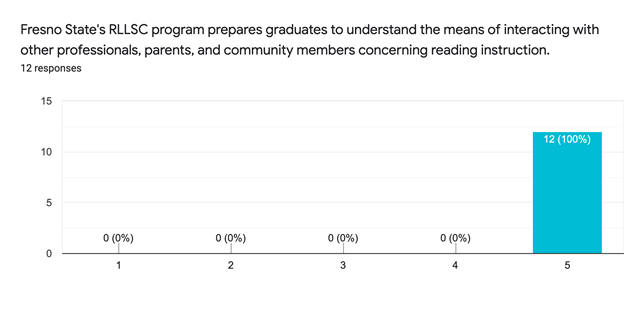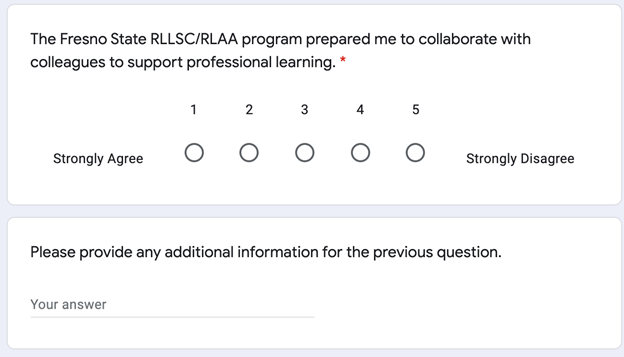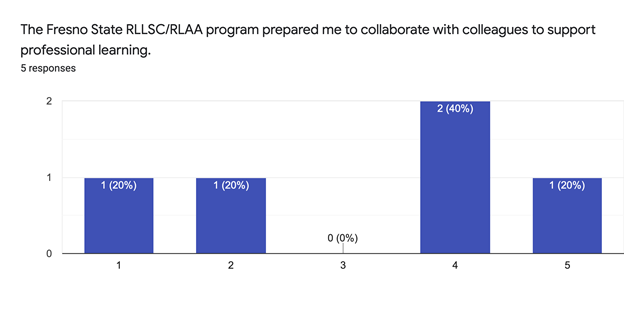AAQEP Accreditation
Standard 2 Aspect F
Standard 2f: Program completers engage in professional practice in educational settings and show that they have the skills and abilities to do so in a variety of additional settings and community/cultural contexts. For example, candidates must have broad and general knowledge of the impact of culture and language on learning, yet they cannot, within the context of any given program, experience working with the entire diversity of student identities, or in all types of school environments.
Candidate preparation includes first-hand professional experience accompanied by reflection that prepares candidates to engage effectively in different contexts they may encounter throughout their careers.
Data Sources & Analysis:
Data Source 1
LEE 254 Program Evaluation Report
Perspective Captured from Data Source: Instructor
Rationale for using Data Source:
LEE 254, Supervised Field Experiences in Reading, is a course our candidates take
during their final semester in the Reading/Literacy program. This course uses field-based
experiences to examine the multiple roles, duties, and expectations of reading professionals
across K-12 settings.
Within this course, candidates complete a Program Evaluation Report where candidates use evaluation tools and school data to construct an evaluation report of their school sites’ literacy program. Candidates provide analysis of data regarding school instructional procedures and curriculum materials, the strengths and weaknesses of these elements, and conclusions regarding program enhancements and professional development.
The overall assignment is scored using a rubric. For the purposes of determining whether or not our candidates have the necessary abilities to support developing positive learning and work environments, we chose to focus on the rubric dimension “Professional Development.”
This rubric component assesses candidates’ ability to analyze the data collected from the report and current research to identify areas of need for colleagues’ professional development.
Specific Elements of Data Source:
LEE 254 Program Evaluation Report Rubric
Professional Development
| Components | Excellent (10) | Fair (7) | Poor (6) |
|---|---|---|---|
| Professional Development | Clearly identifies areas of need for future PD. Content of PD is strongly supported by evidence in the report and formats for PD are supported by at least 4 research references from PD literature and Adult Learning Theory literature. | Report identifies most areas of need for future professional development. Some content of PD is not supported by evidence in the report and recommended processes/formats for PD are supported by less than 4 research references from PD literature and Adult Learning Theory literature. | Report does not identify a need for future professional development. Many PD recommendations not supported by report or 4 research references from PD literature and Adult Learning Theory literature. |
Definition of Success for Each Element:
As a program, our goal is for candidates to score at least to a score of 8 out of
10, as this demonstrates that candidates exhibit at least general ability to identify
areas of need for future professional development based on the findings from the program
evaluation. 75% of students are expected to meet the learning outcome.
Displays of Analyzed Data:
| Semester (Students) | Professional Development Recommendations (average out of 10) |
% of students meeting goal |
|---|---|---|
| 2019 (12 students) | 8.67 | 66.7% (8/12) |
| 2020 (15 students) | 9.27 | 86.6% (13/15) |
Link to Full Dataset:
Interpretation of Data:
In 2019, 66.7% of students were assigned a rubric score of 80% or higher. After analyzing
this data, the instructor tailored their feedback to facilitate research- and evidence-based
professional development. In 2020, 86% of students were assigned a rubric score of
80% or higher, indicating that a majority of students in the program clearly identified
areas of need for future PD. For these students, content of PD is strongly supported
by evidence in the report and formats for PD are supported by at least 4 research
references from PD literature and Adult Learning Theory literature.
Data Source 2
Reading, Language, Literacy Specialist Credential Completer Survey
Perspective Captured from Data Source: Candidate/Completer (prior to graduation)
Rationale for using Data Source:
Beginning in Fall 2020, the RLLSC Program began administering a survey to candidates
upon their completion of the program as a way to learn more about their perceptions
of how well the program prepared them to work with other professionals in their education
settings.
Specific Elements of Data Source:

Definition of Success for Each Element:
Programmatically, our goal is for candidates to rate the program at a 4 or a 5 within
each area.
Displays of Analyzed Data:

Link to Full Dataset:
RLLSC Program Completion Survey Data (Names Redacted)
Interpretation of Data:
Because the program only began administering the completion survey in Fall 2020, we
only have one cycle of data to analyze. Of the 12 completers surveyed, all 12 provided
responses for a response rate of 100%.
Overwhelmingly, the completers who responded indicated they strongly agreed that the program prepared them to interact with other professionals regarding reading/literacy instruction.
Data Source 3
Reading, Language, Literacy Specialist Credential Year+ Completer Pilot Survey
Perspective Captured from Data Source:
Program completer at least one year or more out of program completion
Rationale for using Data Source:
Beginning in late Spring 2021, the RLLSC Program administered a pilot survey to program
completers who completed the program at least one year or more prior to Spring 2021.
This pilot survey was administered to learn the perceptions of how well the program
prepared them to collaborate with colleagues to support professional learning.
Using the RLLSC Year+ Completer Pilot Survey allows us to capture candidates’ perceptions of how well the program prepared them with content and pedagogy necessary to carry out their role as Reading Specialists/ Literacy Leaders.
Specific Elements of Data Source:

Definition of Success for Each Element:
Because this is a new pilot survey we have not set a programmatic goal and are hoping
to learn areas of need for our program with this survey. Eventually, our goal is for
candidates to rate the program at a 4 or a 5 within each area.
Displays of Analyzed Data:
Data from May/June 2021 Data Cycle

Qualitative Responses:
“I presented my final project with my colleagues to our district leadership”
Link to Full Dataset:
RLLSC Year+ Completer Pilot Survey (Names Redacted)
Interpretation of Data:
Because the program only began administering the Year+ Completer Pilot survey in May
2021, we only have one (partial) cycle of data to analyze. The pilot survey was sent
to 56 RLLSC program completers from years 2015-2020 in early May 2021 and again in
June 2021. As of July 14, 2021, five responded to the survey.
The completers who responded indicated a range of opinions whether the program prepared them to collaborate with colleagues. The qualitative response supports the “strongly agree” responses with one completer sharing that they presented their project with colleagues to their district leadership.
Next Steps:
In order to address what we found, we will develop a LEE 254 assignment where candidates
will collaborate to support each other’s learning. This can include a professional
development planning assignment where candidates work collaboratively to create a
professional development addressing an area of need at their school sites. Teams of
candidates can present their professional development experiences to the class and
receive feedback from their classmates.
We will continue to send both the completer and Year + completer surveys out each year and as a program, analyze the data for feedback and trends. Additionally, we plan to conduct focus group interviews with year+ completers and develop an employer pilot survey, both of which will be created and piloted in the 2021-22 academic year.